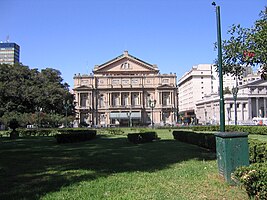Colon Theater ( Spanish Teatro Colón - Columbus Theater) is an opera house in Buenos Aires ( Argentina ).
| Theater "Colon" | |
|---|---|
 | |
| Based | 1908 |
| Theater building | |
| Location | Buenos Aires , Argentina |
| Architect | |
| Manual | |
| Director | Pedro Pablo Garcia Caffi |
| Main director | Esteban Ganzer |
| Chief Conductor | Reinaldo Sensabella |
| Chief Choreographer | Lydia Segni |
| Chief choirmaster | Marcelo Ayub |
| Site | teatrocolon.org.ar |
Content
Creation History
In the mid-1850s, opera in Argentina experienced rapid flourishing: it was only in 1854 that 53 opera productions were performed on various stages in Buenos Aires. There was a need for the emergence of a new theater, and in 1856 it was founded, and on April 27, 1857, the La Traviata opera by Giuseppe Verdi (only four years after its European premiere) was solemnly opened. The new theater contained about 2,500 spectators and included a special gallery especially for women.
New building
30 years after the opening, it became clear that a more comfortable and modern room was needed, and the building was sold to the National Bank of Argentina in order to use the money to build a new one. The current building of the Colon Theater was laid out in 1889 according to the design of architects Francesco Tamburini and Vittorio Meano , however, its construction was accompanied by constant delays and difficulties: both architects died Angelo Ferrari, and only in 1908 the building was completed by the architect Jules (Julio) Dormalem , slightly changed the project and re-designed the finish. The new building was opened on May 25, 1908, on Argentina’s national holiday - the Day of the Homeland, with Verdi’s Aida opera. It still had about 2,500 seats, plus the ability to listen to concerts while standing for a significant number (from 500 to 1000) of viewers. The interiors of the theater were richly decorated; busts of outstanding composers were installed in the lobby: Beethoven , Bellini , Bizet , Wagner , Verdi , Gounod , Mozart and Rossini .
Ballet Troupe
In 1925, a permanent ballet troupe appeared in the theater, headed by George Kyaksht : on October 24, she opened her program with the ballet “Children's Scenes” ( Spanish Escenas infantiles ) by composer Kayetano Trojani [1] . In the 1920s and 1930s, Russian choreographers worked in the Colon Theater, performing in particular ballet performances:
- 1926 - the renewal of B. F. Nizhinsky “ Lesvka ” by I. F. Stravinsky [2]
- 1927 - “Ala and Lolly” to the music of the “ Scythian Suite ” by S. S. Prokofiev , choreography by B. F. Nizhinskaya [3]
- 1930 - “The Clown ” by S. S. Prokofiev, choreography by B. G. Romanov [4]
Current State
In October 2006, the theater was closed for repairs and was supposed to reopen on May 25, 2008, on its centenary, but delays prevented this. As a result, the opening of the theater was timed to another significant date - the 200th anniversary of the Argentine statehood on May 25, 2010 [5] . On this day, a gala concert was held, which was attended by a number of high-ranking officials of Argentina, as well as the President of Uruguay, José Mujica . Fragments from Puccini ’s La Boheme , Zupay ’s poem by Pascual de Rogatis and Tchaikovsky ’s Swan Lake ballet were performed at the concert.
In 2018, November 30 - December 1, the G-20 Summit was held at the Colon Theater.
Theater Interiors
Auditorium
Golden Hall ( Salón dorado )
Auditorium (1935)
Notes
- ↑ Enrique Honorio Destaville. Según pasan los años Archival copy of March 13, 2008 on the Wayback Machine (isp.)
- ↑ Surits, E. Ya. Svechebka // Russian Ballet: Encyclopedia / Ed. E. P. Belova, G. N. Dobrovolskaya , V. M. Krasovskaya , E. Ya. Surits. - M .: Great Russian Encyclopedia, Consent, 1997. - 632 p. - 10 000 copies - ISBN 5-85270-099-1 .
- ↑ Vanslov V. V. Prokofiev Sergey Sergeevich // Ballet: Encyclopedia / Ch. ed. Yu. N. Grigorovich . - M .: Soviet Encyclopedia, 1981. - 623 p.
- ↑ Pappe B. M. Romanov Boris Georgievich // Ballet: Encyclopedia / Ch. ed. Yu. N. Grigorovich . - M .: Soviet Encyclopedia, 1981. - 623 p.
- ↑ The official site of the theater "Colon" (Spanish)